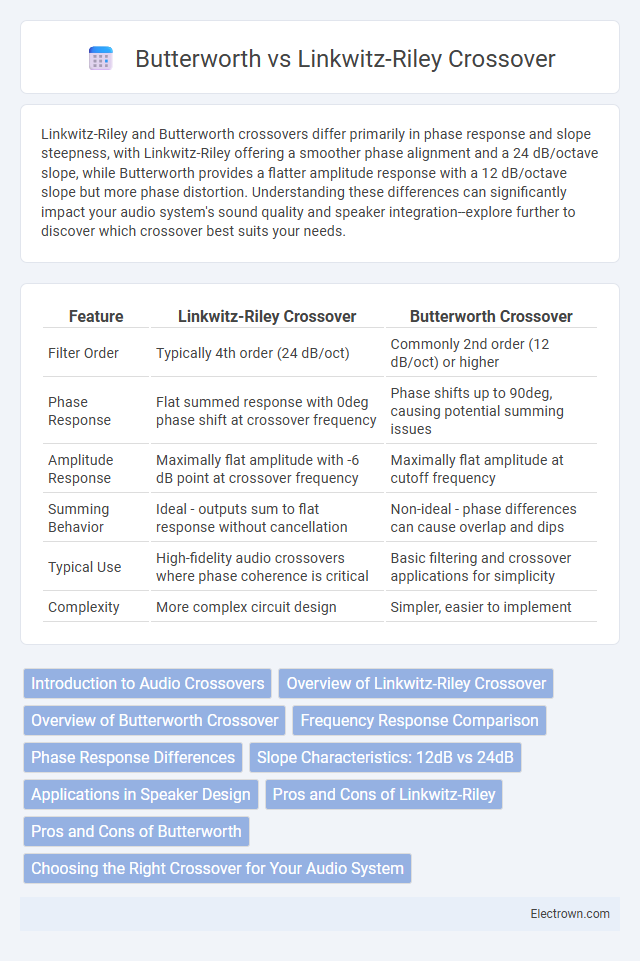Linkwitz-Riley and Butterworth crossovers differ primarily in phase response and slope steepness, with Linkwitz-Riley offering a smoother phase alignment and a 24 dB/octave slope, while Butterworth provides a flatter amplitude response with a 12 dB/octave slope but more phase distortion. Understanding these differences can significantly impact your audio system's sound quality and speaker integration--explore further to discover which crossover best suits your needs.
Table of Comparison
| Feature | Linkwitz-Riley Crossover | Butterworth Crossover |
|---|---|---|
| Filter Order | Typically 4th order (24 dB/oct) | Commonly 2nd order (12 dB/oct) or higher |
| Phase Response | Flat summed response with 0deg phase shift at crossover frequency | Phase shifts up to 90deg, causing potential summing issues |
| Amplitude Response | Maximally flat amplitude with -6 dB point at crossover frequency | Maximally flat amplitude at cutoff frequency |
| Summing Behavior | Ideal - outputs sum to flat response without cancellation | Non-ideal - phase differences can cause overlap and dips |
| Typical Use | High-fidelity audio crossovers where phase coherence is critical | Basic filtering and crossover applications for simplicity |
| Complexity | More complex circuit design | Simpler, easier to implement |
Introduction to Audio Crossovers
Audio crossovers divide sound frequencies to ensure speakers perform optimally within their range. Linkwitz-Riley crossovers provide flat sum response and phase coherence by combining Butterworth filters, minimizing distortion at crossover points. Your choice between Linkwitz-Riley and Butterworth depends on the desired sound clarity and system design requirements.
Overview of Linkwitz-Riley Crossover
Linkwitz-Riley crossover is a popular audio filter design known for its 24 dB/octave slope created by cascading two Butterworth filters, resulting in a flat amplitude response at the crossover frequency. This design minimizes phase distortion and provides a smooth transition between drivers, making it ideal for high-fidelity speaker systems and bi-amping configurations. Its 4th-order alignment ensures that both drivers share equal amplitude and phase at the crossover point, enhancing overall sound coherence and imaging.
Overview of Butterworth Crossover
Butterworth crossovers feature a maximally flat frequency response with a -3 dB point at the crossover frequency, ensuring smooth amplitude transitions between drivers. Their 12 dB/octave (2nd order) slope provides moderate phase shift but requires careful alignment to avoid driver overlap issues. Unlike Linkwitz-Riley crossovers, Butterworth designs do not inherently sum to a flat response, often resulting in dip or peak around the crossover point.
Frequency Response Comparison
Linkwitz-Riley crossovers provide a flat frequency response at the crossover point due to their phase alignment, resulting in minimal amplitude dips and a smooth transition between drivers. Butterworth crossovers exhibit a -3 dB point at the crossover frequency, causing a slight dip or peak in the combined frequency response when drivers are summed. This difference makes Linkwitz-Riley crossovers preferable for achieving accurate and natural sound reproduction in audio systems.
Phase Response Differences
Linkwitz-Riley crossovers provide a flat summed amplitude response with a 360-degree phase shift, ensuring minimal phase distortion at the crossover frequency and resulting in smoother audio transitions. Butterworth crossovers have a 180-degree phase shift, causing more phase cancellation and less coherent summation between drivers. Choosing Linkwitz-Riley will improve your system's phase alignment and overall sound clarity compared to Butterworth designs.
Slope Characteristics: 12dB vs 24dB
Linkwitz-Riley crossovers feature a 24dB/octave slope characterized by a 4th-order filter design, providing a flat summed amplitude response and minimal phase distortion at the crossover frequency. Butterworth crossovers, available in 12dB/octave (2nd-order) and 24dB/octave (4th-order) slopes, prioritize a maximally flat frequency response but can introduce phase shifts that affect sound coherence. The 12dB Butterworth slope offers gentler attenuation and less phase shift compared to 24dB slopes but may result in less precise driver separation and increased overlap in speaker outputs.
Applications in Speaker Design
Linkwitz-Riley crossovers deliver a flat amplitude response and phase coherence at crossover frequency, making them ideal for multi-way speaker systems where precise driver integration and soundstage accuracy are critical. Butterworth crossovers provide a maximally flat magnitude response but introduce phase shifts that can cause driver overlap issues, frequently used in simpler or cost-sensitive speaker designs. Speaker designers select Linkwitz-Riley filters to ensure seamless blending of drivers in high-fidelity audio systems, while Butterworth filters remain a popular choice for basic two-way speakers due to their simplicity and efficient implementation.
Pros and Cons of Linkwitz-Riley
Linkwitz-Riley crossovers provide a flat amplitude response and phase alignment at the crossover frequency, ensuring smooth sound transition and minimal lobing in multi-driver speaker systems. Their main advantage is the 24 dB/octave slope, which offers excellent driver protection and reduced distortion, while the primary drawback is increased complexity and potential phase issues outside the crossover region. Your audio setup benefits from Linkwitz-Riley crossovers when precise phase coherence and seamless blending are priorities in high-fidelity sound reproduction.
Pros and Cons of Butterworth
Butterworth crossovers offer a maximally flat frequency response in the passband, ensuring smooth audio transition without ripples, which results in a clean and natural sound. However, Butterworth filters exhibit a phase shift that can cause less precise driver integration compared to Linkwitz-Riley crossovers, potentially affecting speaker imaging and soundstage. Their gentler slope may also result in less effective driver protection against out-of-band frequencies.
Choosing the Right Crossover for Your Audio System
Choosing the right crossover for your audio system depends on your desired sound quality and speaker characteristics. Linkwitz-Riley crossovers provide a flat response at the crossover frequency and minimal phase distortion, ideal for achieving seamless audio integration. Butterworth crossovers offer a maximally flat amplitude response but can cause phase issues, making them suitable for simpler setups where phase coherence is less critical.
linkwitz-riley vs butterworth crossover Infographic

 electrown.com
electrown.com